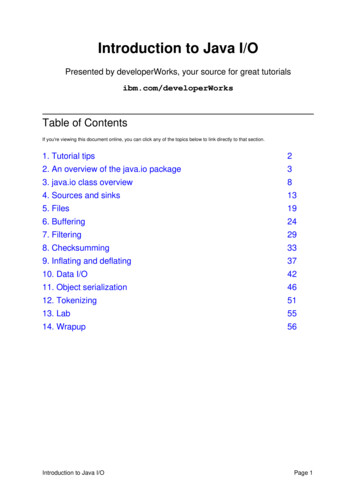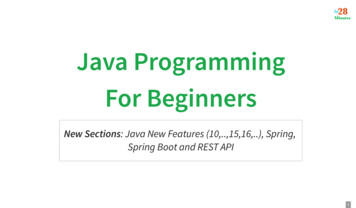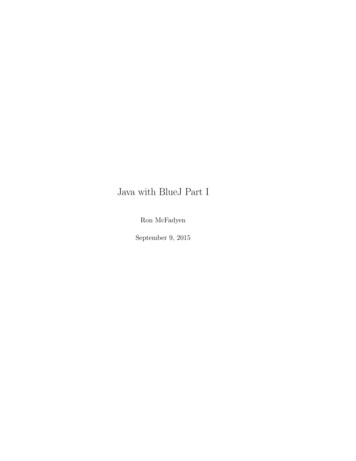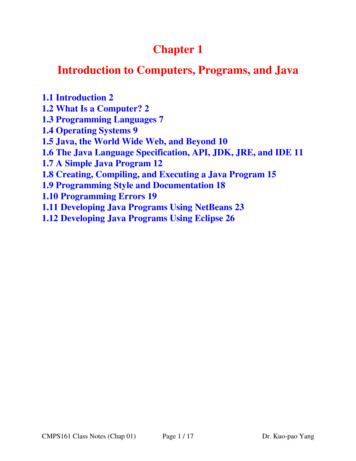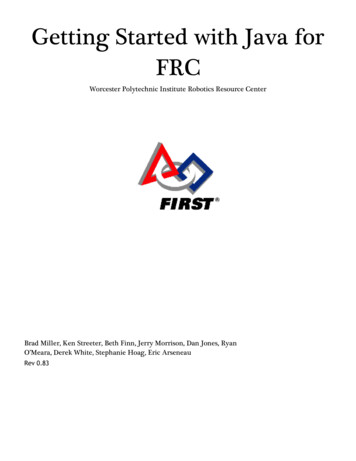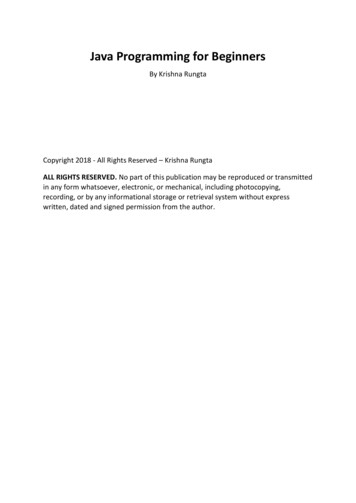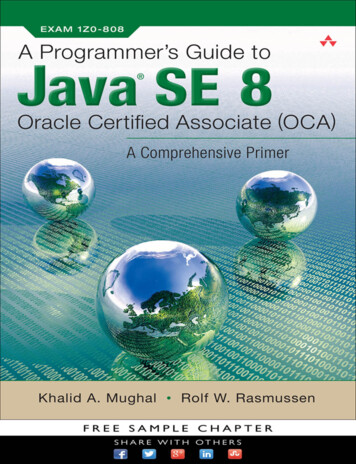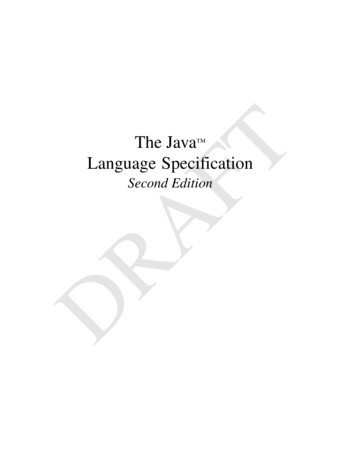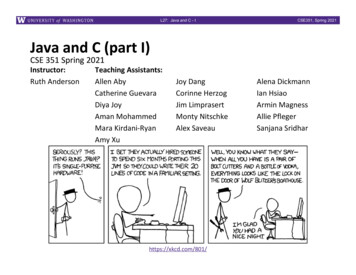
Transcription
L27: Java and C - ICSE351, Spring 2021Java and C (part I)CSE 351 Spring 2021Instructor:Ruth AndersonTeaching Assistants:Allen AbyCatherine GuevaraDiya JoyAman MohammedMara Kirdani‐RyanAmy XuJoy DangCorinne HerzogJim LimprasertMonty NitschkeAlex Saveauhttps://xkcd.com/801/Alena DickmannIan HsiaoArmin MagnessAllie PflegerSanjana Sridhar
L27: Java and C - ICSE351, Spring 2021Administrivia Unit Summary #3 – due TONIGHT Friday (5/28) Submitted by Monday 5/31 – one day late Submitted by Tuesday 6/01 – two days late hw25 – Do EARLY, will help with Lab 5 (due Tues 6/01)Lab 5 (on Mem Alloc) due the last day of class (6/04) Light style grading Can be submitted at most ONE day late. (Sun 6/06) Questions Docs: Use @uw google account to access!! https://tinyurl.com/CSE351‐21sp‐Questions2
L27: Java and C - ICSE351, Spring 2021Lab 5 Hints Struct pointers can be used to access field values,even if no struct instances have been created – justreinterpreting the data in memory Pay attention to boundary tag data Size value 2 tag bits – when do these need to be updatedand do they have the correct values? The examine heap function follows the implicit free listsearching algorithm – don’t take its output as “truth” Learn to use and interpret the trace files for testing!!! A special heap block marks the end of the heap3
L27: Java and C - ICSE351, Spring 2021RoadmapC:Java:car *c malloc(sizeof(car));c- miles 100;c- gals 17;float mpg get mpg(c);free(c);Car c new Car();c.setMiles(100);c.setGals(17);float mpg c.getMPG();Assemblylanguage:Machinecode:get mpg:pushqmovq.popqret%rbp%rsp, %rbp%rbpMemory & dataIntegers & floatsx86 assemblyProcedures & stacksExecutablesArrays & structsMemory & cachesProcessesVirtual memoryMemory allocationJava vs. 0111000010110000011111101000011111Computersystem:4
L27: Java and C - ICSE351, Spring 2021Java vs. C Reconnecting to Java (hello CSE143!) But now you know a lot more about what really happenswhen we execute programs We’ve learned about the following items in C; nowwe’ll see what they look like for Java: Representation of dataPointers / referencesCastingFunction / method calls including dynamic dispatch5
L27: Java and C - ICSE351, Spring 2021Worlds Colliding CSE351 has given you a “really different feeling”about what computers do and how programs execute We have occasionally contrasted to Java, but CSE143may still feel like “a different world” It’s not – it’s just a higher‐level of abstraction Connect these levels via how‐one‐could‐implement‐Java in351 terms6
L27: Java and C - ICSE351, Spring 2021Meta‐point to this lecture None of the data representations we are going to talkabout are guaranteed by Java In fact, the language simply provides an abstraction(Java language specification) Tells us how code should behave for different languageconstructs, but we can't easily tell how things are reallyrepresented But it is important to understand an implementation of thelower levels – useful in thinking about your program7
L27: Java and C - ICSE351, Spring 2021Data in Java Integers, floats, doubles, pointers – same as C “Pointers” are called “references” in Java, but are muchmore constrained than C’s general pointers Java’s portability‐guarantee fixes the sizes of all types Example: int is 4 bytes in Java regardless of machine No unsigned types to avoid conversion pitfalls Added some useful methods in Java 8 (also use bigger signed types)null is typically represented as 0 but “you can’t tell”Much more interesting: Arrays Characters and strings Objects8
L27: Java and C - ICSE351, Spring 2021Data in Java: Arrays Every element initialized to 0 or nullLength specified in immutable field at start of array (int: 4B) array.length returns value of this field Since it has this info, what can it do?C:int array[5];? ? ? ? ?0 420Java:int[] array new int[5];5 00 00 00 00 000 420 249
L27: Java and C - ICSE351, Spring 2021Data in Java: Arrays Every element initialized to 0 or nullLength specified in immutable field at start of array (int: 4B) array.length returns value of this field Every access triggers a bounds‐check Code is added to ensure the index is within bounds Exception if out‐of‐boundsC:int array[5];? ? ? ? ?0 420Java:int[] array new int[5];5 00 00 00 00 000 420 24To speed up bounds‐checking: Length field is likely in cache Compiler may store length fieldin register for loops Compiler may prove that somechecks are redundant10
L27: Java and C - ICSE351, Spring 2021Data in Java: Characters & Strings Two‐byte Unicode instead of ASCII Represents most of the world’s alphabets String not bounded by a '\0' (null character) Bounded by hidden length field at beginning of string All String objects read‐only (vs. StringBuffer)Example: the string “CSE351”C:(ASCII)43 53 45 33 35 31 \00 174Java:(Unicode)6043 00 53 00 45 00 33 00 35 00 31 00164811
L27: Java and C - ICSE351, Spring 2021Data in Java: Objects Data structures (objects) are always stored by reference, neverstored “inline” Include complex data types (arrays, other objects, etc.) using referencesC:Java:struct rec {int i;int a[3];struct rec *p;};class Rec {int i;int[] a new int[3];Rec p;.} a[] stored “inline” as part ofstruct a stored by reference in objecti ai a04p1604p1220243041612
L27: Java and C - ICSE351, Spring 2021Pointer/reference fields and variables In C, we have “- ” and “.” for field selection depending onwhether we have a pointer to a struct or a struct (*r).a is so common it becomes r- a In Java, all non‐primitive variables are references to objects We always use r.a notation But really follow reference to r with offset to a, just like r- a in C So no Java field needs more than 8 bytesC:Java:struct rec *r malloc(.);struct rec r2;r- i val;r- a[2] val;r- p &r2;r new Rec();r2 new Rec();r.i val;r.a[2] val;r.p r2;13
L27: Java and C - ICSE351, Spring 2021Pointers/References Pointers in C can point to any memory addressReferences in Java can only point to [the starts of] objects Can only be dereferenced to access a field or element of that objectC:Java:struct rec {int i;int a[3];struct rec *p;};struct rec* r malloc( );some fn(&(r- a[1])); // ptrclass Rec {int i;int[] a new int[3];Rec p;}Rec r new Rec();some fn(r.a, 1); // ref, indexrri ai a04p160244p12203 int[3]0 41614
L27: Java and C - ICSE351, Spring 2021Casting in C (example from Lab 5) Can cast any pointer into any other pointer Changes dereference and arithmetic behaviorstruct BlockInfo {size t sizeAndTags;struct BlockInfo* next;struct BlockInfo* prev;};typedef struct BlockInfo BlockInfo;.int x;BlockInfo *b;BlockInfo *newBlock;.newBlock (BlockInfo *) ( (char *) b x.s n p08 16 24Cast b into char * todo unscaled additionCast back intoBlockInfo * to useas BlockInfo struct);s n px15
L27: Java and C - ICSE351, Spring 2021Type‐safe casting in Java Can only cast compatible object references Based on class hierarchyclass Object {.}class Vehicle {int passengers;}class Boat extends Vehicle {int propellers;}class Car extends Vehicle {int wheels;}Vehicle v new Vehicle(); // super class of Boat and CarBoatb1 new Boat();// -- siblingCarc1 new Car();// -- siblingVehicle v1 new Car();Vehicle v2 v1;Carc2 new Boat();Carc3 new Vehicle();Boatb2 (Boat) v;CarCarc4 (Car) v2;c5 (Car) b1;16
L27: Java and C - ICSE351, Spring 2021Type‐safe casting in Java Can only cast compatible object references Based on class hierarchyclass Object {.}class Boat extends Vehicle {int propellers;}class Vehicle {int passengers;}class Car extends Vehicle {int wheels;}Vehicle v new Vehicle(); // super class of Boat and CarBoatb1 new Boat();// -- siblingCarc1 new Car();// -- siblingVehicle v1 new Car();Vehicle v2 v1;Carc2 new Boat();Carc3 new Vehicle();Boatb2 (Boat) v;CarCarc4 (Car) v2;c5 (Car) b1; Everything needed for Vehicle also in Car v1 is declared as type Vehicle Compiler error: Incompatible type – elements inCar that are not in Boat (siblings)17
L27: Java and C - ICSE351, Spring 2021Type‐safe casting in Java Can only cast compatible object references Based on class hierarchyclass Object {.}class Boat extends Vehicle {int propellers;}class Vehicle {int passengers;}class Car extends Vehicle {int wheels;}Vehicle v new Vehicle(); // super class of Boat and CarBoatb1 new Boat();// -- siblingCarc1 new Car();// -- siblingVehicle v1 new Car();Vehicle v2 v1;Carc2 new Boat();Carc3 new Vehicle();Boatb2 (Boat) v;CarCarc4 (Car) v2;c5 (Car) b1; Everything needed for Vehicle also in Car v1 is declared as type Vehicle Compiler error: Incompatible type – elements inCar that are not in Boat (siblings) Compiler error: Wrong direction – elements Carnot in Vehicle (wheels) Runtime error: Vehicle does not contain allelements in Boat (propellers) v2 refers to a Car at runtime Compiler error: Unconvertable types – b1 isdeclared as type Boat18
L27: Java and C - ICSE351, Spring 2021Java Object Definitionsclass Point {double x;double y;Point() {x 0;y 0;}boolean samePlace(Point p) {return (x p.x) && (y p.y);}}.Point p new Point();.fieldsconstructormethod(s)creation19
L27: Java and C - ICSE351, Spring 2021Java Objects and Method DispatchPoint objectpheader vptrxyvtable for class Point:code for samePlace()code for Point()Point objectqheader vptr xyVirtual method table (vtable) Like a jump table for instance (“virtual”) methods plus other class info One table per class Each object instance contains a vtable pointer (vptr) Object header : GC info, hashing info, lock info, etc.20
L27: Java and C - ICSE351, Spring 2021Java Constructors pWhen we call new: allocate space for object (data fields andreferences), initialize to zero/null, and run constructor methodJava:C pseudo‐translation:Point p new Point();Point* p calloc(1,sizeof(Point));p- header .;p- vptr &Point vtable;p- vptr[0](p);Point objectheader vptrxyvtable for class Point:code for Point()code for samePlace()21
L27: Java and C - ICSE351, Spring 2021Java Methods Static methods are just like functionsInstance methods: Can refer to this; Have an implicit first parameter for this; and Can be overridden in subclasses The code to run when calling an instance method is chosen atruntime by lookup in the vtableJava:C pseudo‐translation:p.samePlace(q);p- vptr[1](p, q);pPoint objectheader vptrxyvtable for class Point:code for Point()code for samePlace()22
L27: Java and C - ICSE351, Spring 2021Subclassingclass ThreeDPoint extends Point {double z;boolean samePlace(Point p2) {return false;}void sayHi() {System.out.println("hello");}} Where does “z” go? At end of fields of Point Point fields are always in the same place, so Point code can run onThreeDPoint objects without modification Where does pointer to code for two new methods go? No constructor, so use default Point constructor To override “samePlace”, use same vtable position Add new pointer at end of vtable for new method “sayHi”23
L27: Java and C - ICSE351, Spring 2021Subclassingclass ThreeDPoint extends Point {double z;boolean samePlace(Point p2) {return false;}void sayHi() {System.out.println("hello");}}z tacked on at endThreeDPoint objectheader vptrxyzsayHi tacked on at endvtable for ThreeDPoint: constructor(not Point)samePlaceOld code forconstructorsayHiNew code forsamePlaceCode forsayHi24
L27: Java and C - ICSE351, Spring 2021Dynamic DispatchPoint objectheader vptrxyPoint vtable:pcode for Point’s samePlace()?code for Point()ThreeDPoint objectheader vptrxyzcode for sayHi()ThreeDPoint vtable:code for ThreeDPoint’s samePlace()Java:C pseudo‐translation:Point p ?;return p.samePlace(q);// works regardless of what p isreturn p- vtr[1](p, q);25
L27: Java and C - ICSE351, Spring 2021Ta‐da! In CSE143, it may have seemed “magic” that aninherited method could call an overridden method The “trick” in the implementation is this part:p- vptr[i](p,q) In the body of the pointed‐to code, any calls to (other)methods of this will use p- vptr Dispatch determined by p, not the class that defined amethod26
L27: Java and C - I CSE351, Spring 2021 Administrivia Unit Summary #3 – due TONIGHT Friday (5/28) Submitted by Monday 5/31 –one day late Submitted by Tuesday 6/01 –two days late hw25 –Do EARLY, will help with Lab 5 (due Tues 6/01) Lab 5 (on Mem Al



